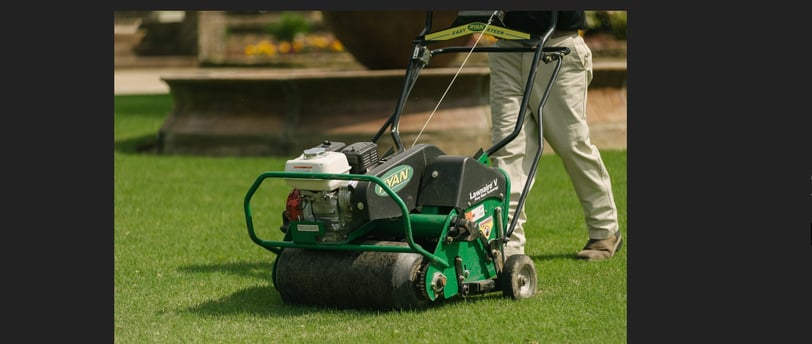The Importance of Aeration for Cool-Season Grasses: Unlocking a Healthier Lawn
For homeowners with cool-season grasses, maintaining a lush and vibrant lawn can be a rewarding yet challenging endeavor. Cool-season grasses, such as Kentucky bluegrass, fescue, and ryegrass, thrive in cooler temperatures and generally experience their peak growth in spring and fall. To keep these grasses looking their best, aeration plays a pivotal role. Let’s delve into why aeration is especially important for cool-season grasses and how it can help you achieve a thriving, green lawn.
8/24/20243 min read


What is Lawn Aeration?
Lawn aeration involves perforating the soil with small holes to alleviate soil compaction and improve the flow of air, water, and nutrients to the root zone. This is typically accomplished using a core aerator, which extracts small plugs of soil from the lawn, leaving behind holes that facilitate better soil conditions for root development.
Why Aeration is Crucial for Cool-Season Grasses
1. Mitigates Soil Compaction
Cool-season grasses can suffer from soil compaction due to factors like heavy foot traffic, frequent use of lawn equipment, or natural settling. Compacted soil restricts root growth and inhibits the movement of water and nutrients. Aeration helps alleviate compaction by creating channels in the soil, allowing roots to expand more freely and access the resources they need.
2. Promotes Robust Root Development
Healthy roots are essential for the overall health of your cool-season grass. Aeration encourages deeper root growth by improving soil conditions. Deeper roots can access more moisture and nutrients, enhancing the grass’s ability to withstand drought and other stressors, leading to a more resilient and vigorous lawn.
3. Enhances Nutrient and Water Uptake
In compacted soil, water and fertilizers can struggle to reach the root zone effectively. Aeration improves the efficiency of water and nutrient absorption by creating pathways for these vital resources to penetrate the soil. This ensures that your cool-season grass receives the nourishment it needs to flourish.
4. Reduces Thatch Accumulation
Thatch, a layer of dead grass and organic material that builds up on the soil surface, can impede water and nutrient penetration. While a thin layer of thatch can be beneficial, excessive thatch can create problems. Aeration helps break down thatch by exposing it to air and promoting its natural decomposition, improving the overall health of your lawn.
5. Improves Soil Structure
Aeration contributes to better soil structure by alleviating compaction and promoting a healthier balance of soil particles. Improved soil structure enhances drainage, reduces the risk of waterlogging, and creates a more stable environment for root growth. This is especially important for cool-season grasses, which can be sensitive to poor soil conditions.
6. Supports Effective Fertilization and Overseeding
For cool-season grasses, aeration is particularly beneficial when fertilizing or overseeding. The holes created during aeration allow fertilizers and seeds to make direct contact with the soil, leading to more effective nutrient uptake and seed germination. This results in a healthier, denser lawn that can better withstand the challenges of the growing season.
7. Boosts Lawn Resilience
A well-aerated lawn is better equipped to handle environmental stressors such as extreme temperatures, disease, and heavy use. By improving soil conditions and root health, aeration helps your cool-season grass recover more quickly from these challenges, ensuring a more robust and attractive lawn.
When and How to Aerate Cool-Season Grasses
- Timing: The best times to aerate cool-season grasses are early spring or early fall. These periods align with the peak growth phases of cool-season grasses, allowing them to recover quickly and benefit from the improved soil conditions.
- Frequency: Aerating once a year is generally sufficient for most lawns. However, lawns with heavy traffic or clay soil may benefit from more frequent aeration.
- Method: Use a core aerator that removes soil plugs rather than a spike aerator, which merely creates holes. Core aerators are more effective at reducing soil compaction and improving root conditions.
Conclusion
Aeration is a vital component of lawn care for cool-season grasses, providing numerous benefits that contribute to a healthier and more resilient lawn. By alleviating soil compaction, promoting robust root growth, enhancing nutrient and water uptake, and supporting effective fertilization and overseeding, aeration helps your cool-season grass thrive. Incorporating regular aeration into your lawn care routine will ensure that your lawn remains lush, vibrant, and well-prepared to face the challenges of each growing season.
